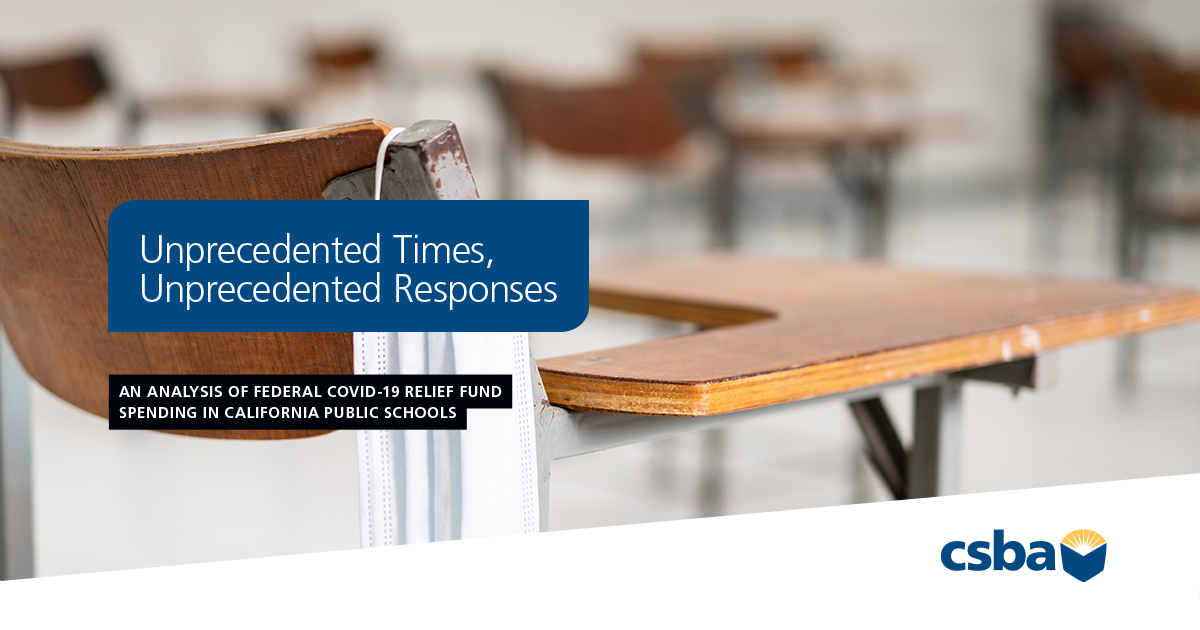More than two years since the COVID-19 pandemic resulted in school closures in March 2020, the federal government has provided billions in relief funding to aid local educational agencies in the United States to continue educating students through distance learning, implement virus-mitigation measures to aid in safe school reopenings, address learning recovery, and support students’ mental and social-emotional health. Whenever the government distributes large sums of money to agencies or individuals, questions follow about whether that funding was used for its intended purpose. For those who are less familiar with the complexity of school operations, it can be difficult to grasp the variables and considerations that impact school spending decisions.
That is why CSBA embarked on an intensive research project examining how districts and county offices of education are using COVID relief funding to support the health and safety, instructional, and social-emotional needs of students and staff. Using a combination of focus group, survey, and state-level expenditure reports, CSBA has developed a three-part series that broadly describes the ways California’s school districts and COEs have used state and federal COVID-19 relief funding. This research also includes the perspectives of superintendents and chief business officials on spending priorities and related implementation issues.
Unprecedented Times, Unprecedented Responses: An analysis of federal COVID-19 relief fund spending in California public schools underscores the necessity of a key element of the relief packages — flexibility. Survey and focus group results round out the picture and give a glimpse not only of the necessity of the relief packages, but of challenges related to spending. For this report, CSBA analyzed more than 900 expenditure reports for the two primary federal COVID-19 relief funds: the Elementary and Secondary School Relief (ESSER) I, II, and III funds and the Governor’s Emergency Education Relief (GEER) Fund.
Key takeaways
Overall, school districts and COEs are spending federal COVID relief in line with deadlines.
Expenditure report data shows that there is a significant range in the amount spent by California’s school districts and COEs in each of the packages. However, on average, recipients in our sample are spending relief funding and are doing so in line with the rolling deadlines. For example, ESSER I has the closest deadline (January 2023) and districts and COEs have spent 94 percent of their allocated funding as of March 31.
Flexibility in using ESSER and GEER funds allows discretion in local spending decisions.
Districts and COEs that received funding had very different needs and were in different starting positions due to the unique circumstances of the COVID-19 pandemic — making the flexible use of funds a necessity. For instance, some districts quickly used most of their earliest allocated funding on educational technology to connect their most vulnerable students who did not have access to the internet or devices for distance learning. In some districts in which students already had 1:1 device ratios, early funding was spent on virus-mitigation measures to prepare schools for reopening.
The flexibility built into these relief packages enables school leaders to react in real time to address the needs of students and staff in one of the most unpredictable periods in education history. When interpreting spending in these categories, it is also important to note that they do not capture how LEAs weaved together multiple streams of funding to address local needs.
Changes in spending reflect the shifting needs of school districts and COEs during different phases of the pandemic.
Changes in spending help to tell the story of how districts and COEs have continued to weather the pandemic over time. During summer 2021, for example, most school districts had partially reopened while still providing some distance learning options, necessitating sustained expenditures on educational technology. Many of those LEAs wanted to avoid the spread of the virus and keep schools open by prioritizing COVID mitigation expenditures, including personal protective equipment (PPE), repairs to reduce virus transmission, the purchase of cleaning supplies, and improving classroom ventilation. During spring 2022, expenditure reports show that districts and COEs were actively trying to address learning recovery through various academic interventions, while also continuing to invest in mitigation measures to keep schools open amid the first Omicron surge of the COVID-19 pandemic.
Common challenges to spending COVID-19 relief funds emerge.
When interpreting how districts and county offices spent their aid, it is essential to acknowledge the landscape in which they developed plans to spend their funding. Some of the most significant impediments to spending included supply chain issues, concerns about funding programs with one-time monies, navigating reporting requirements, and, most acutely, problems with staffing shortages. Matters related to staffing shortages, shipping delays, and planning for long-term obligations were compounded by the timelines and deadlines associated with the spending packages. In CSBA’s survey of superintendents and school business officials, 91 percent said filling vacant or new positions were moderately or very challenging barriers to using relief funding. Staff burnout was another large challenge for LEAs to consider when implementing new programs with federal funding, with 72 percent describing burnout as very challenging and another 22 percent describing it as moderately challenging. Additionally, 70 percent of respondents expressed concern about using one-time funding to hire staff that they may not be able to keep on the payroll once funding runs out.
This research is the first in a series of reports meant to paint a clearer picture of the experiences of school districts and COEs with spending federal and state relief. CSBA’s next reports will explore state funding and then dive into a comprehensive survey of superintendents and chief business officials from 239 school districts and county offices that received COVID relief.





